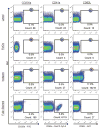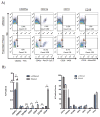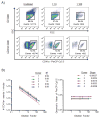Techniques to improve detection and analysis of extracellular vesicles using flow cytometry
- PMID: 25847910
- PMCID: PMC4876854
- DOI: 10.1002/cyto.a.22649
Techniques to improve detection and analysis of extracellular vesicles using flow cytometry
Abstract
Extracellular vesicles (EVs) range in size from 50 nm to 1 µm. Flow cytometry (FCM) is the most commonly used method for analyzing EVs; however, accurate characterization of EVs remains challenging due to their small size and lack of discrete positive populations. Here we report the use of optimization techniques that are especially well-suited for analyzing EVs from a high volume of clinical samples. Utilizing a two pronged approach that included 1) pre-filtration of antibodies to remove aggregates, followed by 2) detergent lysis of a replicate sample to account for remaining false positive events, we were able to effectively limit false positive non-EV events. In addition, we show that lysed samples are a useful alternative to isotypes for setting gates to exclude background fluorescence. To reduce background, we developed an approach using filters to "wash" samples post-staining thus providing a faster alternative to ultracentrifugation and sucrose gradient fractionation. In conclusion, use of these optimized techniques enhances the accuracy and efficiency of EV detection using FCM.
Keywords: antibody aggregates; extracellular vesicles; filtration; flow cytometry; microparticles.
© 2015 International Society for Advancement of Cytometry.
Conflict of interest statement
The authors have no conflict of interest to disclose.
Figures





References
-
- Nolte-’t Hoen ENM, van der Vlist EJ, Aalberts M, Mertens HCH, Bosch BJ, Bartelink W, Mastrobattista E, van Gaal EVB, Stoorvogel W, Arkesteijn GJA, Wauben MHM. Quantitative and qualitative flow cytometric analysis of nanosized cell-derived membrane vesicles. Nanomedicine Nanotechnol Biol Med. 2012;8:712–720. - PMC - PubMed
-
- Van der Pol E, Böing AN, Harrison P, Sturk A, Nieuwland R. Classification, functions, and clinical relevance of extracellular vesicles. Pharmacol Rev. 2012;64:676–705. - PubMed
Publication types
MeSH terms
Substances
Grants and funding
LinkOut - more resources
Full Text Sources
Other Literature Sources

